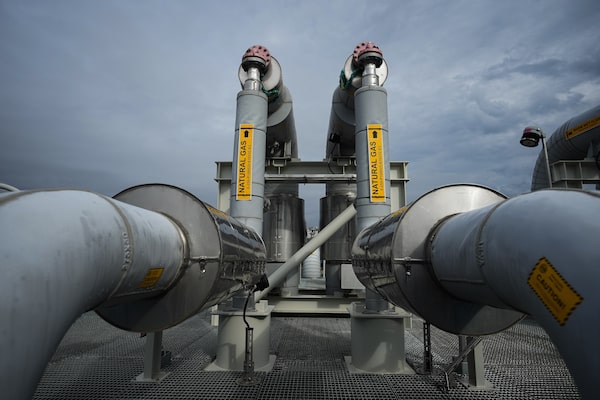
Piping is seen on the top of a receiving platform which will be connected to the Coastal GasLink natural gas pipeline terminus at the LNG Canada export terminal under construction, in Kitimat, B.C., on Sept. 28, 2022.DARRYL DYCK/The Canadian Press
Ryan Bushell is president and portfolio manager at Newhavenam Asset Management Inc.
TC Energy Corp. recently announced a plan to spin off its liquids pipeline business (mainly the original Keystone system) into a standalone entity. The market’s reaction was swift and decisive, sending the shares down more than 16 per cent at one point from already depressed levels.
But TC Energy TRP-T is arguably at the forefront of the opportunity that exists for energy infrastructure development in North America, and recent negative share price performance is an overreaction. Using this frame of reference, it likely matters little whether the plan to split TC Energy is successful or not. The roughly 15 per cent of the company devoted to oil transportation being spun off is immaterial relative to the current size, and opportunities ahead, in the gas and power businesses.
Recently announced final investment decisions for greenfield and brownfield liquified natural-gas facility expansions put total North American LNG export capacity on course to double over the next decade from about 15 billion cubic feet a day to nearly 30 bcf/d. TC Energy already moves 25 per cent of the natural gas on the continent, including 30 per cent of US LNG feed gas, and will move all molecules headed for the LNG Canada project when it comes on stream later this decade. The sheer magnitude of this continuing continental expansion requires significant infrastructure to support development, and TC Energy is poised to capitalize on at least their fair share of the opportunity.
In that context, TC Energy’s bid to spin off its oil unit makes sense. The unfortunate problem is that these long-life gas and power projects require a significant capital investment ahead of when they will generate cash flows, leading to a temporary mismatch of leverage relative to earnings. This is exacerbated when a project incurs delays and/or cost overruns from unforeseen events, something with which TC Energy is all too familiar, given their recent experience with the Coastal Gas Link (CGL) pipeline in British Columbia. With a weakened equity currency, and already high leverage from CGL cost overruns, TC Energy is looking to reorganize ahead of the coming flood of opportunity in order to capitalize.
TC Energy’s ESG-focused split may be the least bad move out of a rotten hand
The plan to carve out the liquids pipeline business will no doubt be the subject of much debate and computing power over the next year or so, as investors attempt to discount TC Energy’s shares based on the shorter-term implications of the strategy. A disconnect exists in the investment community, where long investor timelines clash with short-term incentives for those that control large swaths of capital. A disproportionate amount of intellectual horsepower is spent trying to position around near-term catalysts, like those announced by TC Energy recently, and not nearly enough is spent thinking about the decades of potential in front of the company.
Management’s credibility is on the line with the current plan, but ultimately it will be the quality of the company’s assets, and their future opportunities, that will determine the outcome for patient investors.
A wise investor, George Frazer, once said that “if the assets are good, the management is temporary.” His simple yet powerful advice pertained to Bell Canada Enterprises Inc. BCE-T in late 2007, as its stock price languished in the mid-2000s at about $30. The meaning of the quote is twofold: First, that you want to own companies with assets and opportunities so durable that they will outlast even the best management team; second, that even if things go wrong for a period of time, eventually the market will demand better management of those assets, improving performance.
For BCE, that moment came in 2007 when Ontario Teachers’ Pension Plan offered to buy the company for $42.75 a share, nearly a 50-per-cent premium to the prevailing share price at the time. (Mr. Frazer was not happy about this development, dismayed that a long-term compounder would be taken from him despite the hefty premium.)
Though the deal to purchase BCE eventually fell apart during the global financial crisis, the management team was changed, and the company lived on to capitalize on the insatiable demand for data that continues to this day. Shareholders who purchased BCE during the doldrums prior to the takeout offer have received a solid 330-per-cent return over the next 16 years (about 10-per-cent annualized) with numerous dividend increases along the way.
TC Energy’s nearly fully contracted asset base is strong enough to persevere through this managerial wobble, with better performance in the years ahead expected. Patience is especially scarce in financial markets these days, and those that have some stand to benefit.